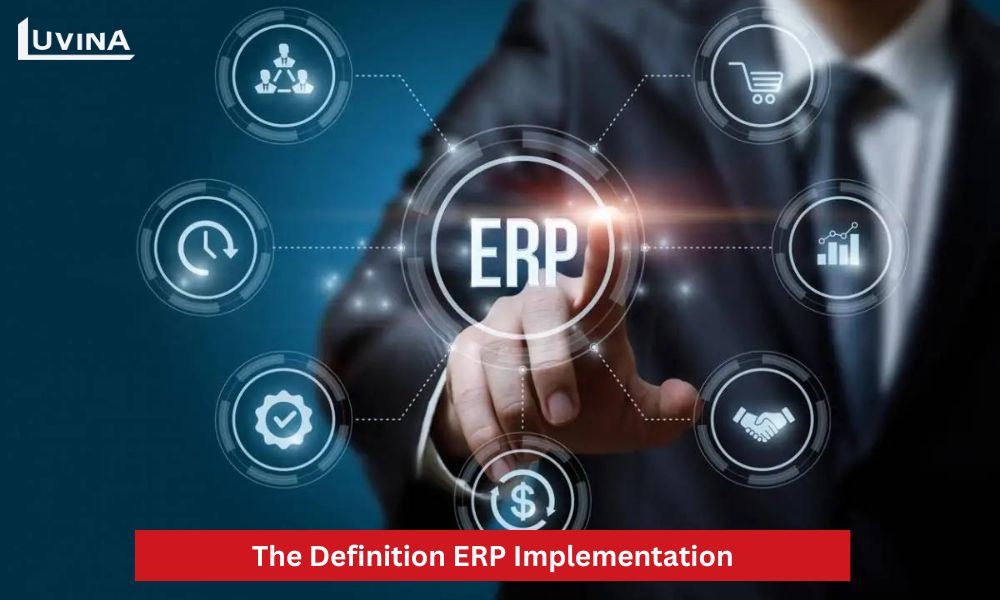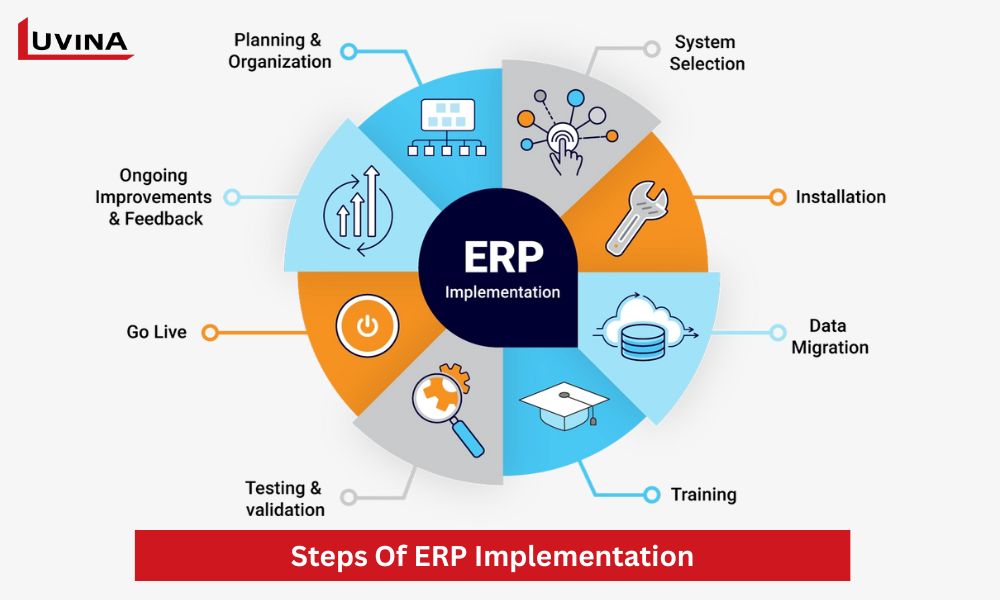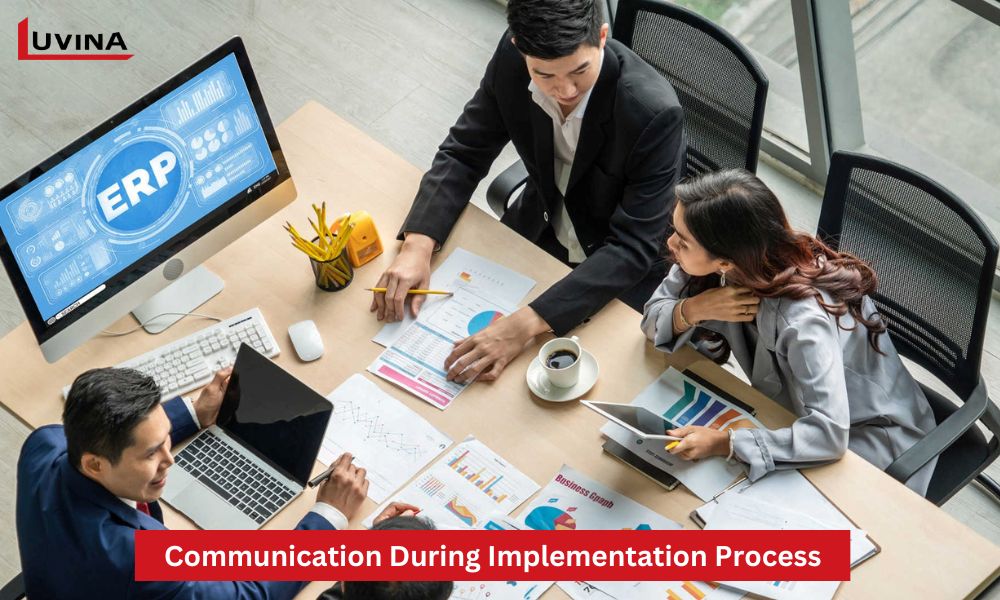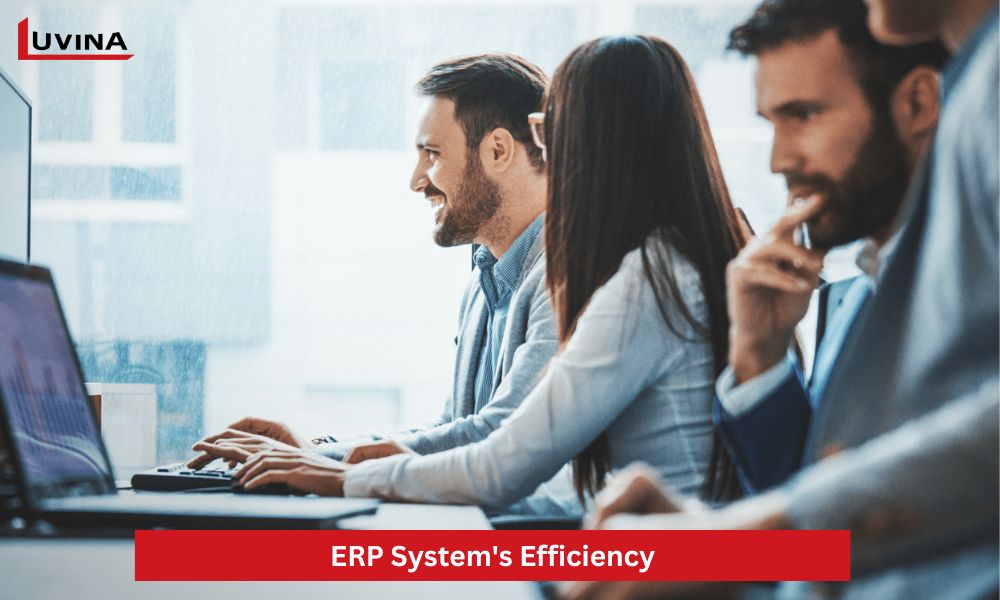According to statistics, up to 95% of businesses acknowledge significant improvements in their business processes after using an ERP system. That’s why ERP implementation is the key to changing the game for every enterprise in any industry. If you want to take your company to new heights, keep reading this article to learn about the ERP implementation process, costs, and effectiveness measurement.
What is ERP Implementation?
ERP implementation is installing ERP software or applying an ERP system to a business operation. During this process, various business functions, such as finance, human resources, administration, etc., are integrated into a single system.

Carrying out an ERP implementation project requires a lot of time and effort. This process typically includes stages like analysis, planning, design, testing, deployment, maintenance, etc. The number of steps in ERP implementation varies from one company to another. Despite being time-consuming and requiring effort, implementing ERP can benefit businesses. ERP implementation benefits include optimizing business processes, saving operational costs, and improving the accuracy of data and reporting.
The Perils of Neglecting an ERP Solution
In the current scenario where every business is automating to optimize processes, not implementing ERP solutions could expose you to several risks:
– Inefficient business operations lead to reduced profits.
– Increased chances of losing or missing information due to decentralized data management.
– Decreased employee productivity.
– Excessive spending on expensive hardware and software hinders business growth.
– Regular encounters with security issues or conflicts with government regulations.
– Inflexible business management interface.
– Lack of connectivity among personnel, making management difficult.
ERP Implementation Process
Every company will have a different ERP implementation process. However, fundamentally, to implement an ERP system, you need to go through the following 9 steps:
Step 1 – Plan for enterprise resource planning (ERP) implementation, including setting goals, budget estimation, etc.
Step 2 – Choose an ERP package based on the business scale and needs.
Step 3 – To select essential features, compare the current business operations with the ERP-supported functions.

Step 4 – Adjust business processes to incorporate new improvements.
Step 5 – Customize the ERP system according to business requirements.
Step 6 – Engage with employees regarding the new system.
Step 7 – Conduct ERP system testing, and identify and rectify errors before real-world application.
Step 8 – Migrate all data to activate the new ERP system.
Step 9 – Continuously maintain the system during operation to promptly detect and address any issues.
>> Also read: 5 Tips to Implement ERP System Maintenance
ERP Implementation Best Practices
Implementing ERP solutions according to the correct steps does not guarantee 100% project success. To have an effective ERP system, during the implementation process, you need to pay attention to the following ERP implementation best practices:
1. Careful and detailed planning
Thorough planning is the foundation stage of the entire project. Planning will help you outline the necessary tasks, and allocate budget and personnel appropriately to ensure the smoothest ERP implementation process.
2. Establish training and support programs for employees
The success of enterprise resource planning ERP system implementation can be evaluated by employees’ understanding and proficiency with the new system. Besides providing direct training for end-users (employees), businesses also need to allocate resources for technical support, updates, and timely issue resolution.
3. Caution in data migration
Data migration is a crucial task during enterprise resource planning and implementation. To ensure efficient data transfer and save time, you need to plan for data cleanup, eliminate old or incorrect data, and transfer only necessary data to the new system.
>> Also read: Everything You Need for a Successful ERP Data Migration
4. Communication is key
Throughout the enterprise resource planning system implementation process, businesses need to maintain regular communication with the development team and engage with employees regarding the reasons for ERP implementation and the benefits of the new system. This is also an opportunity for the development team to listen to user issues and adjust the system accordingly.

5. Choose the Right ERP Implementation Partner
Only some companies can implement a new ERP system independently. Therefore, selecting a suitable ERP system implementation partner plays a crucial role in ensuring the success of the ERP system. Your partners will help you plan a detailed ERP implementation based on your needs, optimizing time and cost for building the new system.
If you are seeking an ERP implementation service, consider collaborating with Luvina. Luvina has a team of over 750 highly skilled IT professionals who can help businesses implement a new ERP system or customize existing systems based on their needs.
Luvina’s team has experience providing ERP consulting & development solutions to clients in both Vietnam and Japan, with a commitment to the best services and maximum support 24/7 regardless of time zones. Over the years, Luvina has accumulated experience working with various quality ERP solutions such as GRANDIT, DYNAMICAX, WORKDAY, SAP, ORACLE, etc. We are confident that we can help businesses choose the most suitable solution.
Contact Luvina now to upgrade your business operations through ERP implementation.
Get in touch now
to get a free consultant from us
How To Measure the Success of the ERP Implementation Project
Measuring the success of an ERP implementation project will help businesses know whether the new system benefits their operations. The success of ERP development can be determined based on several factors, including:
- Cost savings: Compare the implementation, operation, and maintenance costs of the ERP system with the cost savings achieved by using the new ERP system. The more the ERP system helps reduce operational costs, the more worthwhile the investment in ERP deployment.
- Process improvement capability: Monitor and compare the time and resources required to perform important business processes such as financial reporting, inventory management, customer care, etc., before and after using the new ERP system.
- Data accuracy: Compare the accuracy of manually entered data in the system with data automatically entered into the ERP system.
- User acceptance: Track user login rates, the number of transactions processed by the system, etc., to determine the level of employee acceptance of the new ERP system. The more employees use the system, the more valuable it is.
- Return on investment (ROI): Compare the benefits of the system (cost savings, process improvement) with the system’s cost.

Understanding how to measure the success of ERP deployment will help businesses identify what needs improvement, thereby adjusting the system and business strategy accordingly. A system that is regularly monitored and adjusted will better meet the needs of the business.
How Much Does ERP System Implementation Cost?
It’s challenging to determine the exact cost for ERP implementation, as it depends on various factors such as system functionality, customization level, number of users, business structure and scale, training, etc. Each ERP solution provider will have different pricing structures, and costs are not usually disclosed until direct discussions with the business.
On average, the cost of ERP implementation for a medium-sized company can range from $50,000 to $2,000,000 or more. The more complex the requirements, with many custom functionalities, the higher the implementation costs. Additionally, costs are influenced by the number of users, so larger companies will require more investment for enterprise resource planning and ERP system implementation.
Conclusion
Implementing ERP early can help businesses optimize their operations and gain a competitive edge in the market. Although the implementation process involves many complex steps, following the best practices can enable businesses to have a completely new system that streamlines business processes and saves operational costs.
Hope this article has provided you with the most comprehensive overview of ERP implementation. To get a new ERP system that meets your business needs as soon as possible, don’t forget to contact Luvina early for the best-optimized ERP implementation service.
Related Posts:









Read More From Us?
Sign up for our newsletter
Read More From Us?
Sign up for our newsletter